
A hammam, also often called a Turkish bath by Westerners, is a type of steam bath or a place of public bathing associated with the Islamic world. It is a prominent feature in the culture of the Muslim world and was inherited from the model of the Roman thermae. Muslim bathhouses or hammams were historically found across the Middle East, North Africa, al-Andalus, Central Asia, the Indian subcontinent, and in Southeastern Europe under Ottoman rule.

In biochemistry, chemosynthesis is the biological conversion of one or more carbon-containing molecules and nutrients into organic matter using the oxidation of inorganic compounds or ferrous ions as a source of energy, rather than sunlight, as in photosynthesis. Chemoautotrophs, organisms that obtain carbon from carbon dioxide through chemosynthesis, are phylogenetically diverse. Groups that include conspicuous or biogeochemically important taxa include the sulfur-oxidizing Gammaproteobacteria, the Campylobacterota, the Aquificota, the methanogenic archaea, and the neutrophilic iron-oxidizing bacteria.
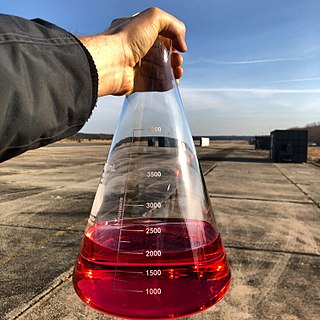
RP-1 and similar fuels like RG-1 and T-1 are highly refined kerosene formulations used as rocket fuel. Liquid-fueled rockets that use RP-1 as fuel are known as kerolox rockets. In their engines, RP-1 is atomized, mixed with liquid oxygen (LOX), and ignited to produce thrust. Developed in the 1950s, RP-1 is outwardly similar to other kerosene-based fuels like Jet A and JP-8 used in turbine engines but is manufactured to stricter standards. While RP-1 is widely used globally, the primary rocket kerosene formulations in Russia and other former Soviet countries are RG-1 and T-1, which have slightly higher densities.
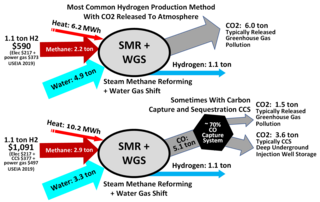
Steam reforming or steam methane reforming (SMR) is a method for producing syngas (hydrogen and carbon monoxide) by reaction of hydrocarbons with water. Commonly natural gas is the feedstock. The main purpose of this technology is often hydrogen production, although syngas has multiple other uses such as production of ammonia or methanol. The reaction is represented by this equilibrium:

Naqsh-e Jahan Square, also known as the Shah Square prior to 1979, is a square situated at the center of Isfahan, Iran. Constructed between 1598 and 1629, it is now an important historical site, and one of UNESCO's World Heritage Sites. It is 160 metres (520 ft) wide by 560 metres (1,840 ft) long. It is also referred to as Shah Square or Imam Square. The square is surrounded by buildings from the Safavid era. The Shah Mosque is situated on the south side of this square. On the west side is the Ali Qapu Palace. Sheikh Lotf Allah Mosque is situated on the eastern side of this square and at the northern side Qeysarie Gate opens into the Isfahan Grand Bazaar. Today, Namaaz-e Jom'eh is held in the Shah Mosque.

The important sulfur cycle is a biogeochemical cycle in which the sulfur moves between rocks, waterways and living systems. It is important in geology as it affects many minerals and in life because sulfur is an essential element (CHNOPS), being a constituent of many proteins and cofactors, and sulfur compounds can be used as oxidants or reductants in microbial respiration. The global sulfur cycle involves the transformations of sulfur species through different oxidation states, which play an important role in both geological and biological processes. Steps of the sulfur cycle are:
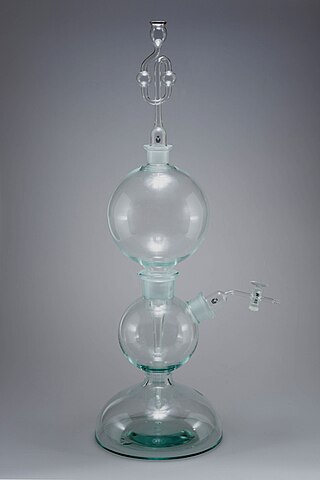
Kipp's apparatus, also called a Kipp generator, is an apparatus designed for preparation of small volumes of gases. It was invented around 1844 by the Dutch pharmacist Petrus Jacobus Kipp and widely used in chemical laboratories and for demonstrations in schools into the second half of the 20th century.

Methyl bisulfate is a chemical compound with the molecular formula (CH3)HSO4. This compound is the mono-methyl ester of sulfuric acid. Its structure is CH3−O−S(=O)2−OH. The significance of methyl bisulfate is that it is an intermediate in the hydrolysis of the important reagent dimethyl sulfate, (CH3)2SO4:
Microbial metabolism is the means by which a microbe obtains the energy and nutrients it needs to live and reproduce. Microbes use many different types of metabolic strategies and species can often be differentiated from each other based on metabolic characteristics. The specific metabolic properties of a microbe are the major factors in determining that microbe's ecological niche, and often allow for that microbe to be useful in industrial processes or responsible for biogeochemical cycles.

Baha al-Din Muhammad ibn Husayn al-Amili, also known as Bahāddīn ʿĀmilī, or just Sheikh Bahāʾi in Iran, was a Levantine Arab Shia Islamic scholar, poet, philosopher, architect, mathematician and astronomer, who lived in the late 16th and early 17th centuries in Safavid Iran. He was born in Baalbek, Ottoman Syria but immigrated in his childhood to Safavid Iran with the rest of his family. He was one of the earliest astronomers in the Islamic world to suggest the possibility of the Earth's movement prior to the spread of the Copernican theory.

Methane is a chemical compound with the chemical formula CH4. It is a group-14 hydride, the simplest alkane, and the main constituent of natural gas. The abundance of methane on Earth makes it an economically attractive fuel, although capturing and storing it is difficult because it is a gas at standard temperature and pressure. In the Earth's atmosphere methane is transparent to visible light but absorbs infrared radiation, acting as a greenhouse gas. Methane is an organic compound, and among the simplest of organic compounds. Methane is also a hydrocarbon.
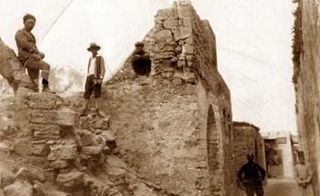
Hamam al-Sammara was a hammam in the Zeitoun Quarter of the Old City of Gaza. It was situated 3 meters (9.8 ft) below street level. It was owned by Salim Abdullah al-Wazeer. The bathhouse was destroyed by airstrike from Israeli forces in December 2023; at the time it was the only active hammam in Gaza.
Hydromethanation, [hahy-droh- meth-uh-ney-shuhn] is the process by which methane is produced through the combination of steam, carbonaceous solids and a catalyst in a fluidized bed reactor. The process, developed over the past 60 years by multiple research groups, enables the highly efficient conversion of coal, petroleum coke and biomass into clean, pipeline quality methane.

Greenhouse gas emissions from wetlands of concern consist primarily of methane and nitrous oxide emissions. Wetlands are the largest natural source of atmospheric methane in the world, and are therefore a major area of concern with respect to climate change. Wetlands account for approximately 20–30% of atmospheric methane through emissions from soils and plants, and contribute an approximate average of 161 Tg of methane to the atmosphere per year.
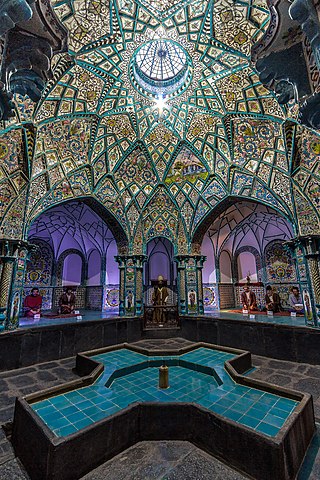
The Four-Season Bathhouse in the Iranian city Arak dates back to the Qajar period, and had two separate sections for ladies and gents. The tile-work of the clock room and spinal designed columns of this area, including the layout of the bath are interesting features. The structure was renovated into a museum after undergoing necessary repairs.

The Ali Gholi Agha hammam is a historical hammam in the Bidabad district of Isfahan, Iran. The hammam was built in 1713 by Ali Gholi Agha, who was a courtier of two Safavid kings Suleiman I and Sultan Husayn. Its architectural style is Isfahani and it was built in the late Safavid era. The structure consists of one large hammam and a small hammam and also a Howz. Each of these hammams consists of a dressing room and a Garmkhaneh (hothouse), so that they could be used in that time separately by men and women. At present, the structure is a museum and can be visited by tourists.
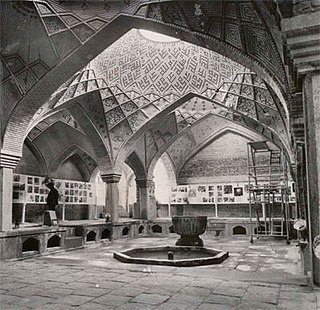
The Khosro Agha hammam was a historical hammam in Iran. It was located in the Sepah street in Isfahan and belonged to the Safavid era.
The Shah Ali hammam is a hammam in Isfahan, Iran.The hammam belongs to the Safavid era.

The Shahi Hammam, also known as the Wazir Khan Hammam, is a Turkish bath which was built in Lahore, Punjab, Pakistan, in 1635 C.E. during the reign of Emperor Shah Jahan. It was built by chief physician to the Mughal Court, Ilam-ud-din Ansari, who was widely known as Wazir Khan. The baths were built to serve as a waqf, or endowment, for the maintenance of the Wazir Khan Mosque.

Kordasht Hammam or the Kordasht Bathhouse is Safavid era Hammam in Kordasht, East Azerbaijan province, Iran.


















